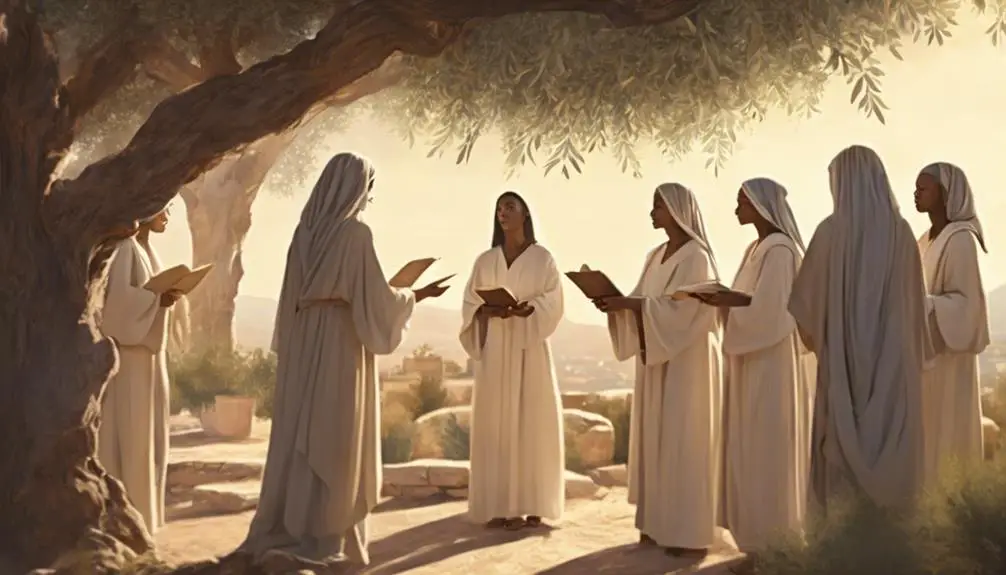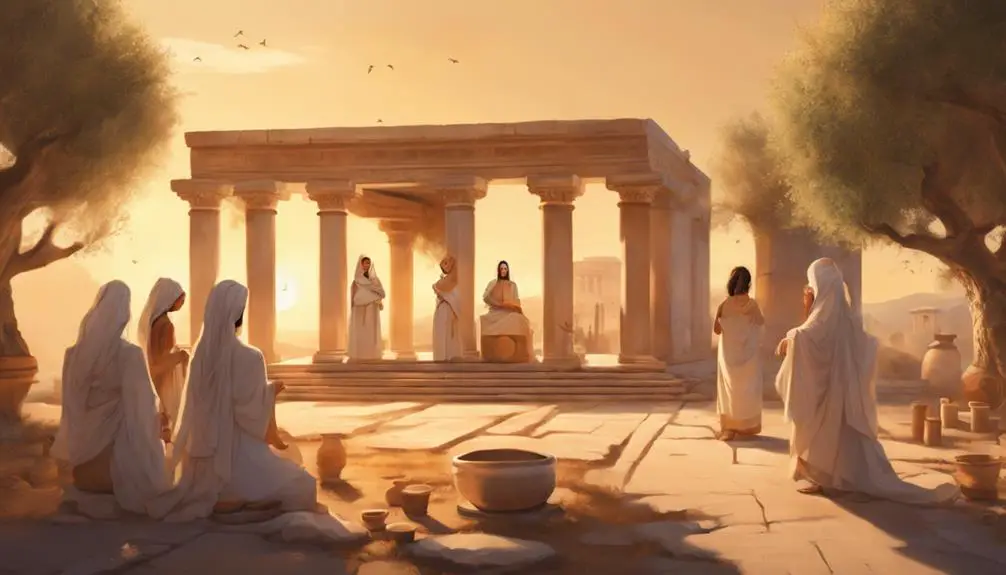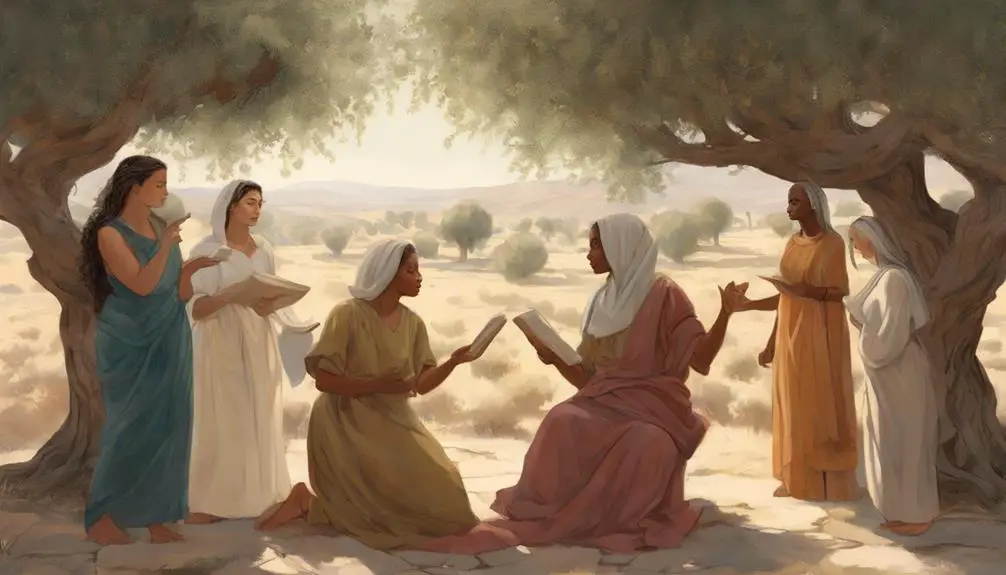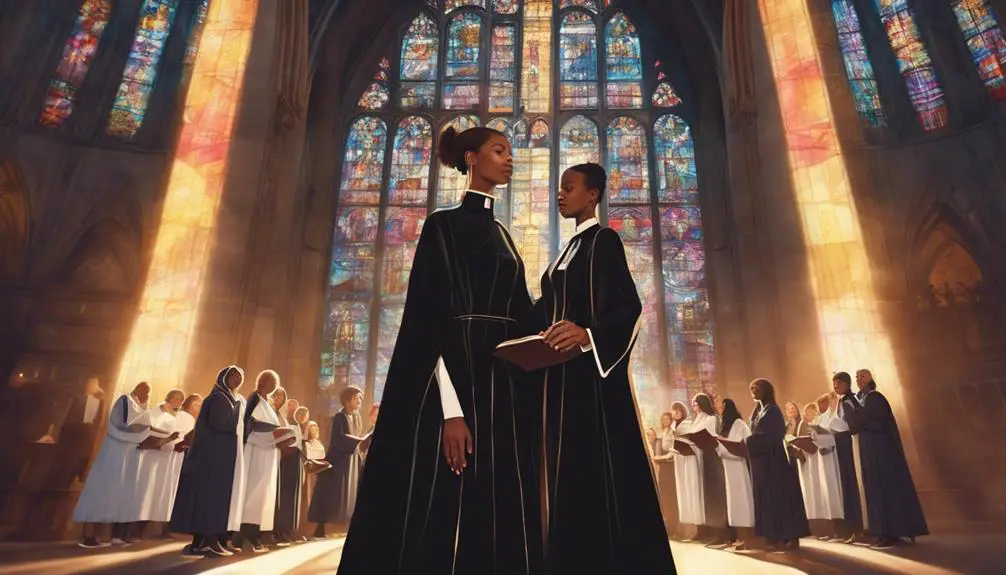Uncover the hidden stories of women priests in the Bible and how they redefine traditional spiritual leadership roles.

Women Priests in the Bible
In the tapestry of biblical narratives, the presence of women in priestly roles is a thread that's often overlooked, yet it weaves a complex and intriguing pattern. You might find yourself questioning how these historical figures challenge or reinforce traditional views on spiritual leadership.
Exploring these stories opens up a dialogue not only about the past but also about how we interpret gender roles in religious practices today. With debates and interpretations evolving, the discussion on female priests in the Bible offers a rich ground for examining the impact on modern religious views and potentially reshaping future perspectives on women's leadership in faith communities.
Why not explore this further to uncover how these ancient narratives resonate in contemporary discussions?
Key Takeaways
- Biblical examples like Deborah and Phoebe highlight women's significant leadership roles despite patriarchal norms.
- Historical challenges for women in priesthood include societal resistance and discriminatory practices within religious hierarchies.
- Modern debates reflect a spectrum from conservative opposition to feminist advocacy for inclusivity in religious leadership.
- Progress in women's spiritual authority is seen through increasing dialogue and reinterpretation of scriptural texts favoring gender inclusivity.
Historical Context of Women Priests

Exploring the historical context of women priests reveals a complex interplay between religious roles and societal norms, challenging conventional narratives about gender and sacred leadership. This inquiry necessitates a deep dive into how cultural norms have historically shaped, and at times, restricted the roles that women could occupy within religious hierarchies. Specifically, the attire designated for priesthood often mirrored broader societal expectations of gender, serving as a visual reinforcement of the roles deemed appropriate or accessible for women in religious contexts.
The nuances of priesthood attire, while seemingly a superficial aspect of religious service, actually underscore a deeper narrative about inclusion and respect within sacred spaces. Cultural norms have long dictated not just the roles that individuals can occupy, but also how they present themselves within those roles, further complicating the path for women who've aspired to priesthood. This attire, therefore, isn't just fabric; it's a symbol of the complex relationship between gender expectations and religious leadership. As such, understanding the historical context of women priests involves dissecting how these cultural norms have both hindered and enabled their journey toward sacred leadership.
Biblical Figures and Priestly Roles
Having considered the historical context of women priests and the impact of cultural norms on their roles, we now turn our focus to examining specific biblical figures who assumed priestly roles, shedding light on their contributions and challenges within sacred narratives.
Miriam's role as a prophetess and leader alongside her brothers, Moses and Aaron, in the Exodus story, highlights a form of spiritual leadership that transcends conventional priestly duties. She's celebrated for her leadership in the song of victory at the Sea of Reeds, embodying a spiritual authority that predates formal priestly structures.
Similarly, Deborah's authority as a prophetess and judge in the book of Judges represents a unique intersection of religious and civil leadership. Her role in leading Israel to military victory and her judicial responsibilities underscore a form of priestly function, albeit not in the traditional sense. Deborah's story challenges traditional notions of leadership and priestly roles, emphasizing the capacity of women to hold significant spiritual and societal authority.
These examples illustrate the nuanced ways in which women engaged with priestly roles, contributing to the religious and social fabric of their communities despite the constraints imposed by their historical and cultural contexts.
Debates and Interpretations

Throughout history, the roles of women as priests in biblical narratives have sparked diverse interpretations and debates among scholars. These discussions often revolve around gender dynamics and scriptural authority, questioning how religious texts should guide contemporary practices.
Scholarly Perspective |
Interpretation of Scriptural Texts |
Impact on Gender Dynamics |
|---|---|---|
Conservative |
Literal interpretation |
Maintains traditional roles |
Liberal |
Contextual analysis |
Promotes egalitarian views |
Feminist |
Critical of patriarchal readings |
Advocates for inclusivity |
Analytically, the conservative view tends to uphold the status quo, interpreting biblical texts as prohibitive of women serving in priestly roles based on a literal understanding. This perspective often cites scriptural authority to justify gender-specific roles within religious institutions.
In contrast, liberal scholars employ a more contextual approach, arguing that cultural and historical contexts should influence the interpretation of sacred texts. They suggest that scriptural references to women in leadership or priestly roles were more reflective of the times and should evolve with societal changes.
Feminist interpretations go further, critically analyzing how gender dynamics have shaped scriptural authority and readings. They advocate for a reinterpretation of texts that have traditionally marginalized women, arguing for a more inclusive understanding that recognizes the potential for women's leadership within religious contexts.
Impact on Modern Religious Views
The interpretations of scriptural texts regarding women in priestly roles significantly influence modern religious views on gender equality within various faith communities. As you delve deeper into the topic, you'll find that the discussion isn't merely theological but intertwined with cultural and social dynamics.
Key points to consider include:
- The role of historical context in shaping current attitudes towards women priests.
- How cultural resistance to gender equality in religious leadership persists.
- The impact of progressive theological interpretations on promoting inclusivity.
- The significance of dialogue between different faith traditions on this issue.
- The role of academic and feminist critique in challenging traditional views.
This analysis reveals a complex web of factors at play, including deeply ingrained cultural norms and the evolving understanding of religious texts. While some communities have embraced change, advocating for gender equality in religious leadership, others remain steadfast in their traditional interpretations, citing historical precedent and doctrinal purity.
Ultimately, the conversation around women priests and gender equality in religious settings is a reflection of broader societal debates about gender roles and equality. It's a testament to the enduring power of religious texts to shape, reflect, and challenge societal norms and values, even in the face of cultural resistance.
Future Perspectives on Women's Leadership

Looking ahead, it's crucial to assess how evolving societal norms might influence future perspectives on women's leadership within religious communities. As the global discourse on gender equality gains momentum, it's expected that religious institutions will increasingly find themselves at a crossroads. The push for more equitable practices within these spaces isn't just a matter of social justice but also a reflection of the growing demand for inclusivity in all areas of life, including spirituality and governance.
The role of leadership training in this evolution can't be overstated. As more women are equipped with the necessary skills and theological education, the barriers that have historically limited their participation in religious leadership are likely to diminish. This shift doesn't only pave the way for more women in leadership positions but also challenges and expands the traditional understanding of spiritual authority.
In this context, the future of women's leadership in religious communities seems poised for significant transformation. The interplay between heightened gender equality awareness and enhanced leadership training for women promises to reshape not only who leads but how leadership is conceptualized and enacted within these sacred spaces.
Frequently Asked Questions
How Do Different Denominations Within Christianity Reconcile Their Current Stance on Women Priests With the Historical and Biblical Evidence?
You're exploring how Christian denominations reconcile their stance on ordaining women with historical and biblical evidence. They delve into scriptural interpretations and ordination traditions. Some view passages as culturally contextual, opening doors for women priests. Others adhere strictly to traditional interpretations, upholding male-only priesthood.
This analysis reveals a complex interplay between evolving societal norms and steadfast religious doctrines, highlighting the diversity of thought within Christianity.
In What Ways Have Non-Biblical Religious Texts or Traditions Influenced the Acceptance or Rejection of Women Priests in Various Christian Communities?
Imagine exploring a tapestry of traditions, where threads of Pagan influences and Secular feminism weave into Christian communities. These non-biblical forces have significantly shaped attitudes towards women priests.
Pagan traditions, often more inclusive of female spiritual roles, alongside the empowering currents of Secular feminism, challenge and inspire various Christian groups to rethink and sometimes embrace the idea of women in priestly roles, marking a profound shift in historical perspectives and practices.
How Have Feminist Theological Approaches Contributed to Reinterpreting Biblical Narratives That Traditionally Exclude Women From Priestly Roles?
You're exploring how feminist theological approaches have reshaped understanding of biblical narratives, specifically around priestly roles. Through gender archaeology, you're uncovering how cultural contexts influenced scriptural semantics, offering fresh interpretations.
This analytical journey reveals that historical readings might've overlooked women's roles due to contemporary biases. By reexamining these texts with a scholarly lens, you're contributing to a broader, more inclusive view of religious leadership that challenges traditional exclusions.
What Practical Challenges Do Women Who Feel Called to Priesthood Face in Denominations That Do Not Ordain Women, and How Do They Navigate Their Vocations?
When faced with a glass ceiling in denominations that don't ordain women, you might find alternative careers or seek out spiritual mentoring.
This journey often requires navigating uncharted territories, where your calling is affirmed through non-traditional roles. Whether it's leading community projects or providing pastoral care, you carve out spaces where your spiritual leadership flourishes.
This approach not only challenges existing norms but also expands the scope of what ministry entails.
How Do Cultural and Societal Attitudes Towards Gender Roles Outside of Religious Contexts Impact the Discussion and Acceptance of Women Priests Within Religious Communities?
You're examining how broader cultural and societal attitudes towards gender roles impact discussions within religious communities. Gender equity and social progress play crucial roles in shaping these perspectives.
As society progresses, traditional views on gender roles evolve, influencing how religious communities view women's ordination. Analyzing this interaction reveals the dynamic between societal norms and religious practices, highlighting the importance of external cultural shifts in advancing the acceptance of women priests.
Conclusion
As you've seen, the journey of women priests through biblical times to the present has been nothing short of a rollercoaster ride through history. Despite the debates and interpretations that often muddle the waters, it's clear that women have played, and continue to play, pivotal roles in spiritual leadership.
This exploration sheds light on an evolving landscape, where the inclusion of women in religious leadership positions could potentially turn the tide of millennia-old traditions, making waves in the stagnant waters of religious orthodoxy.



Sign up